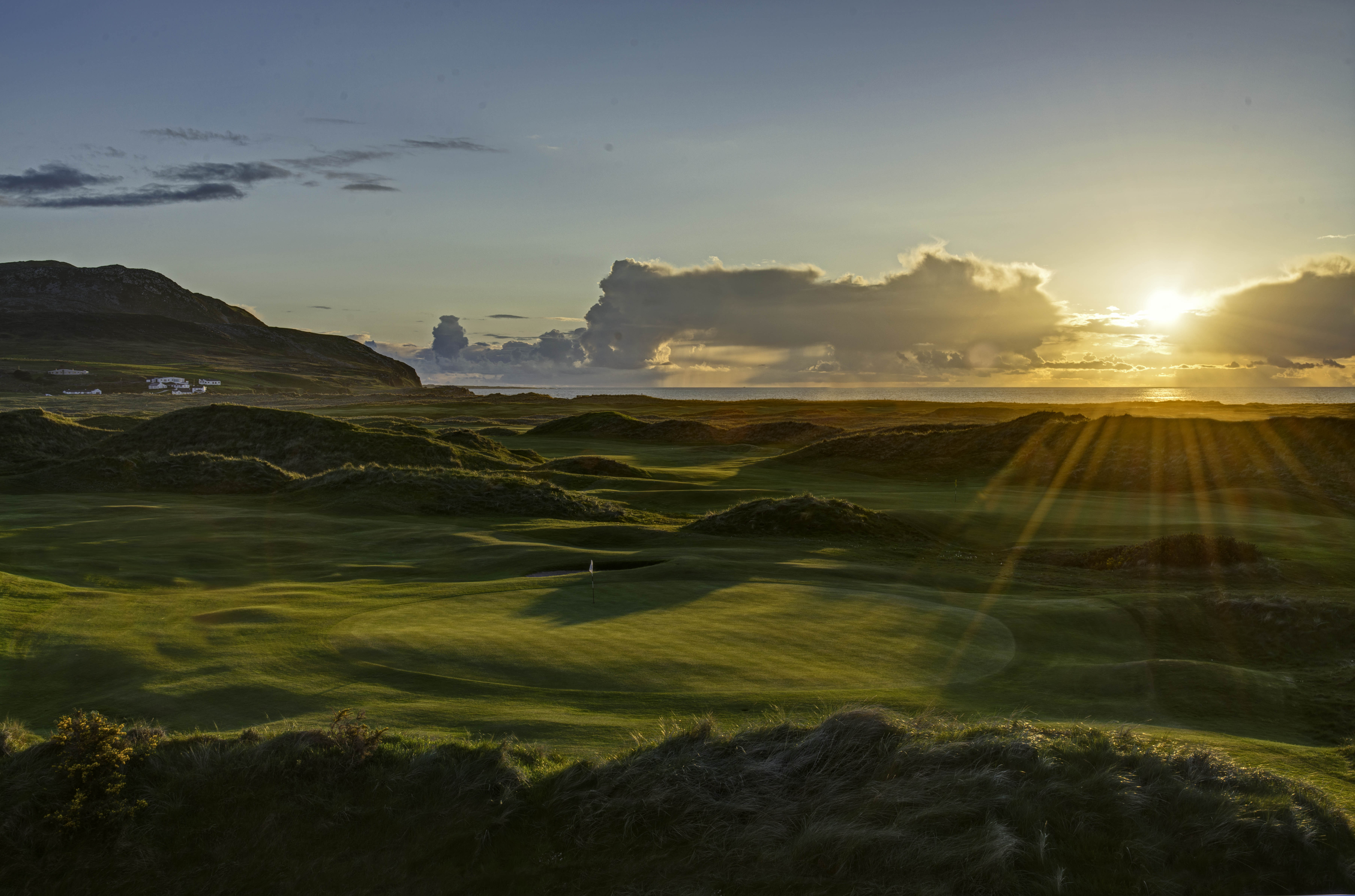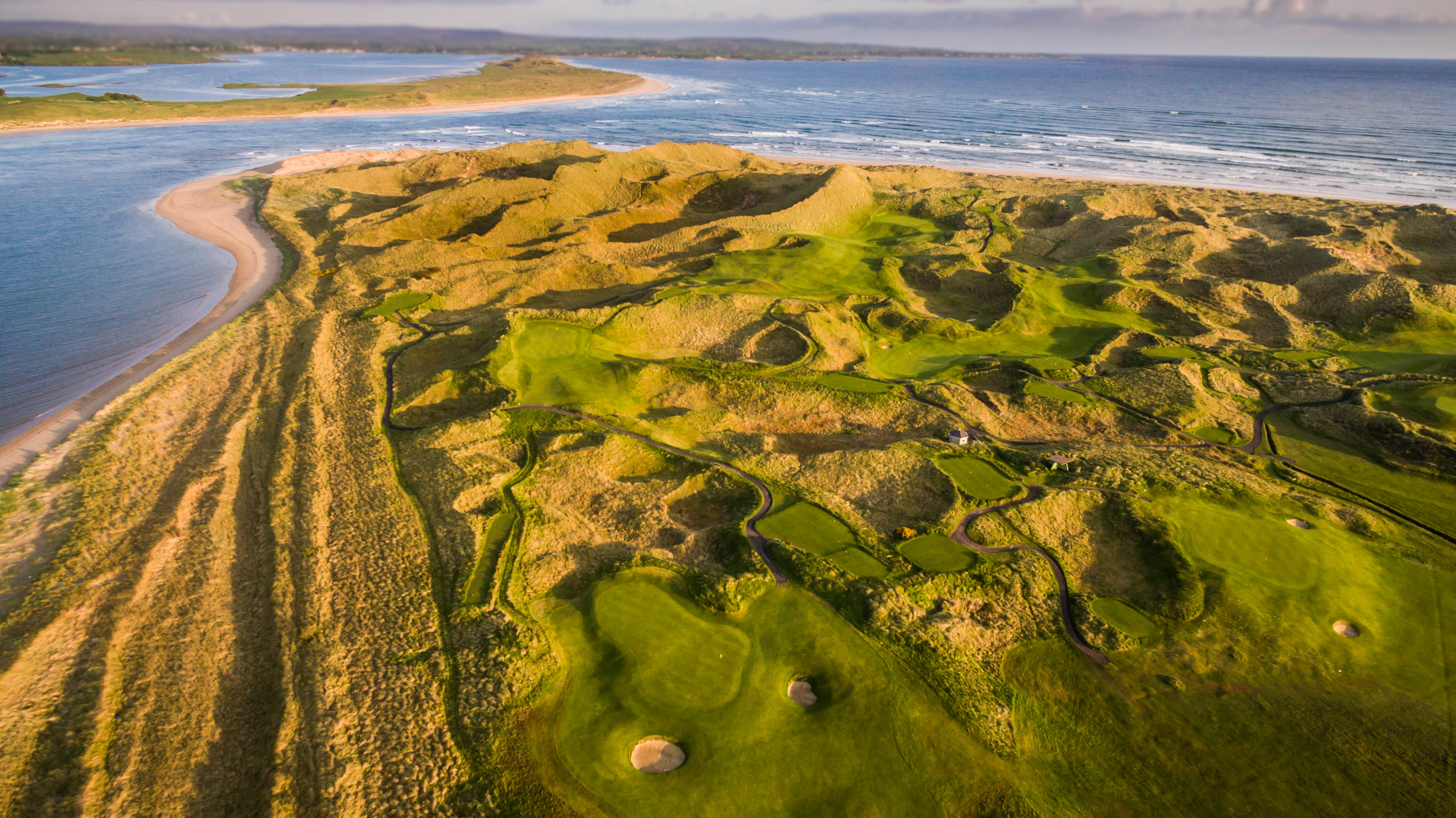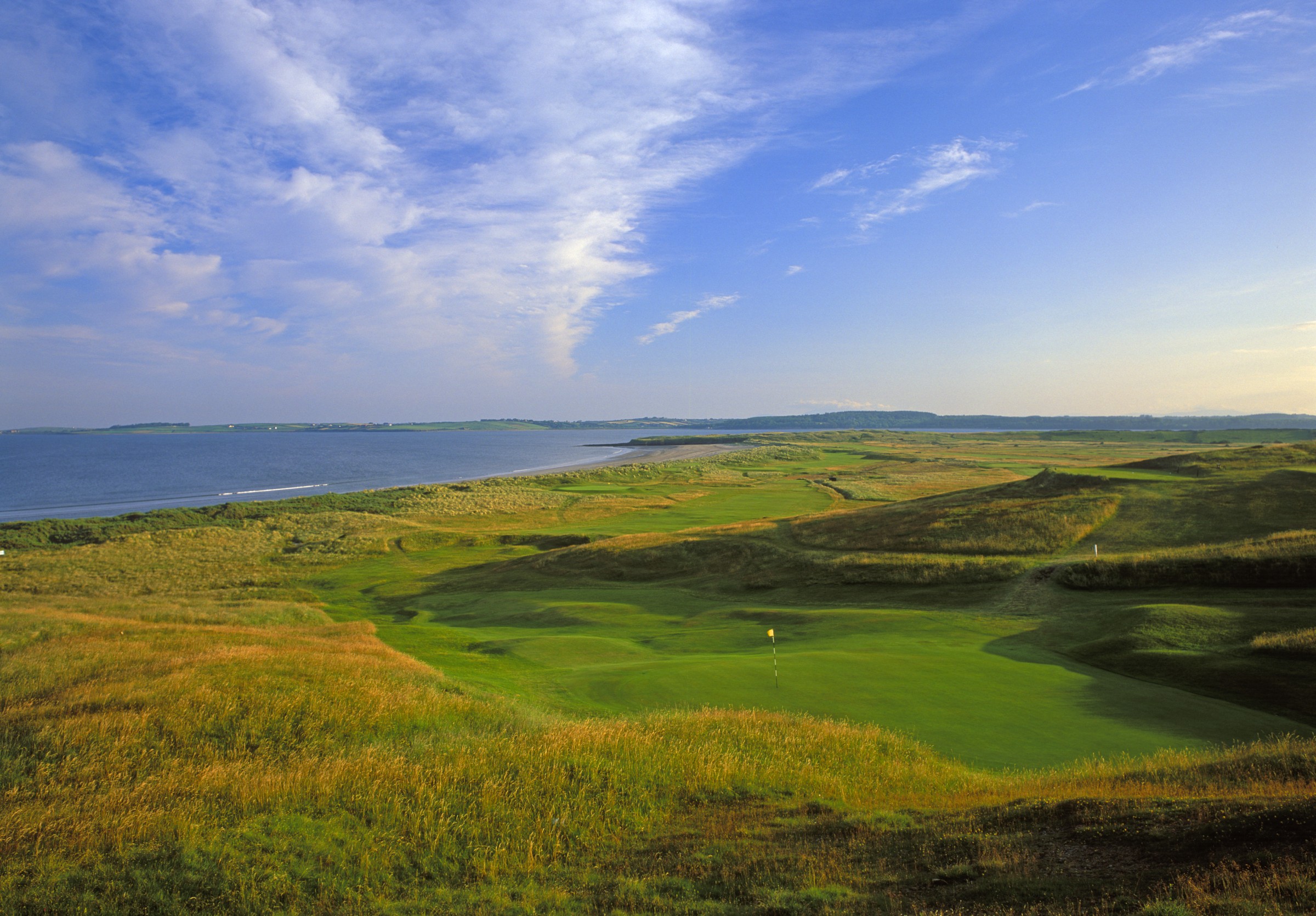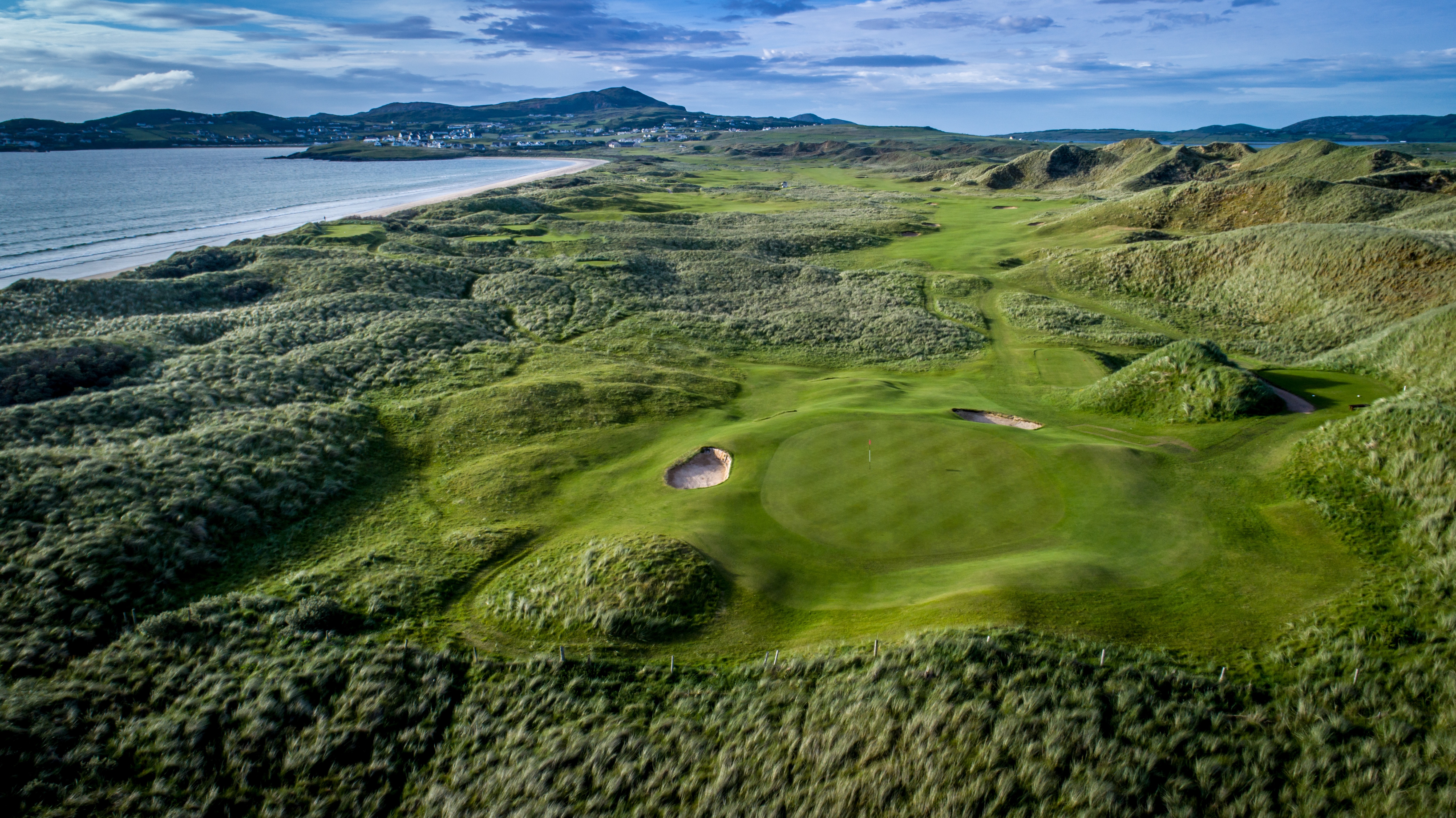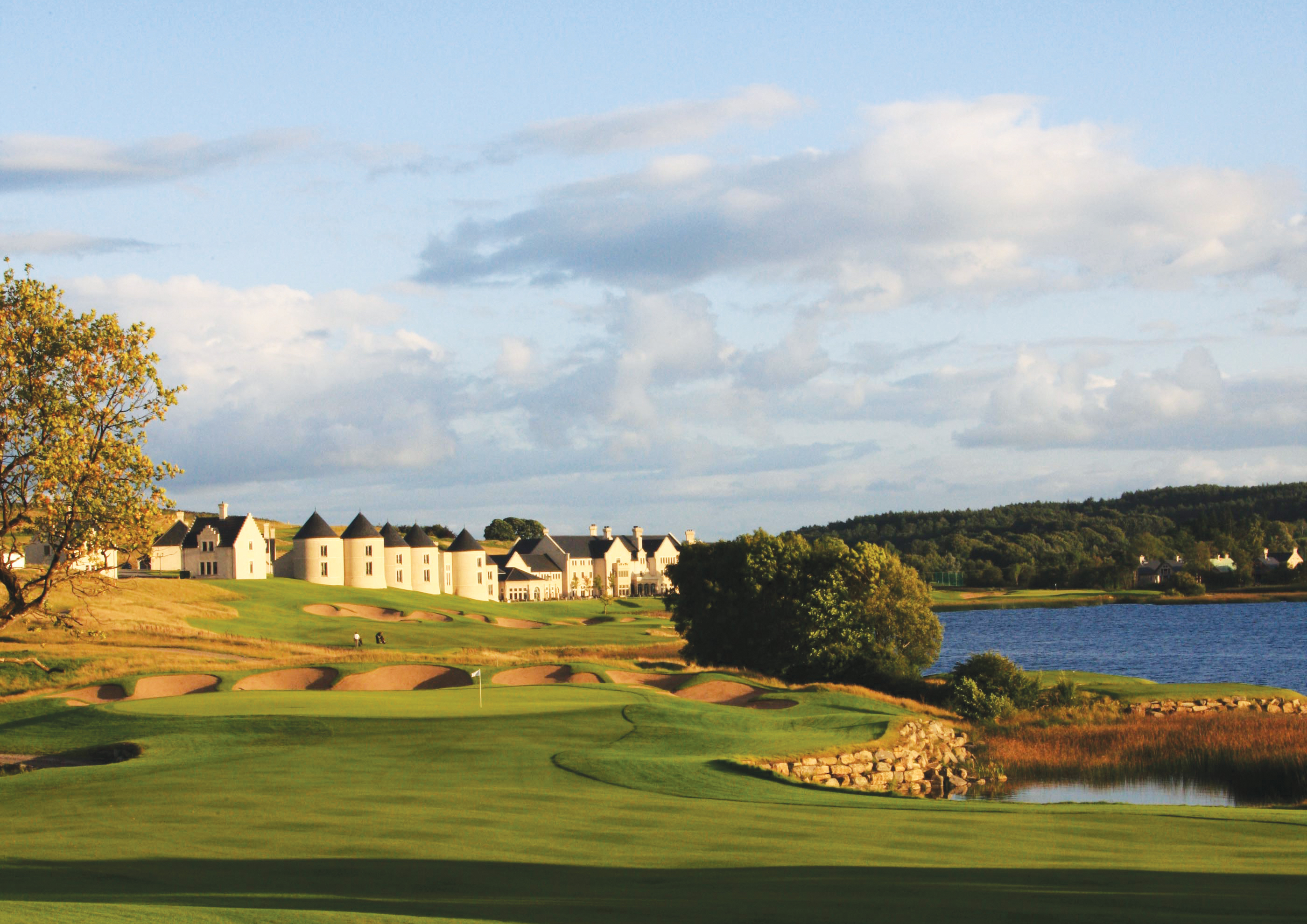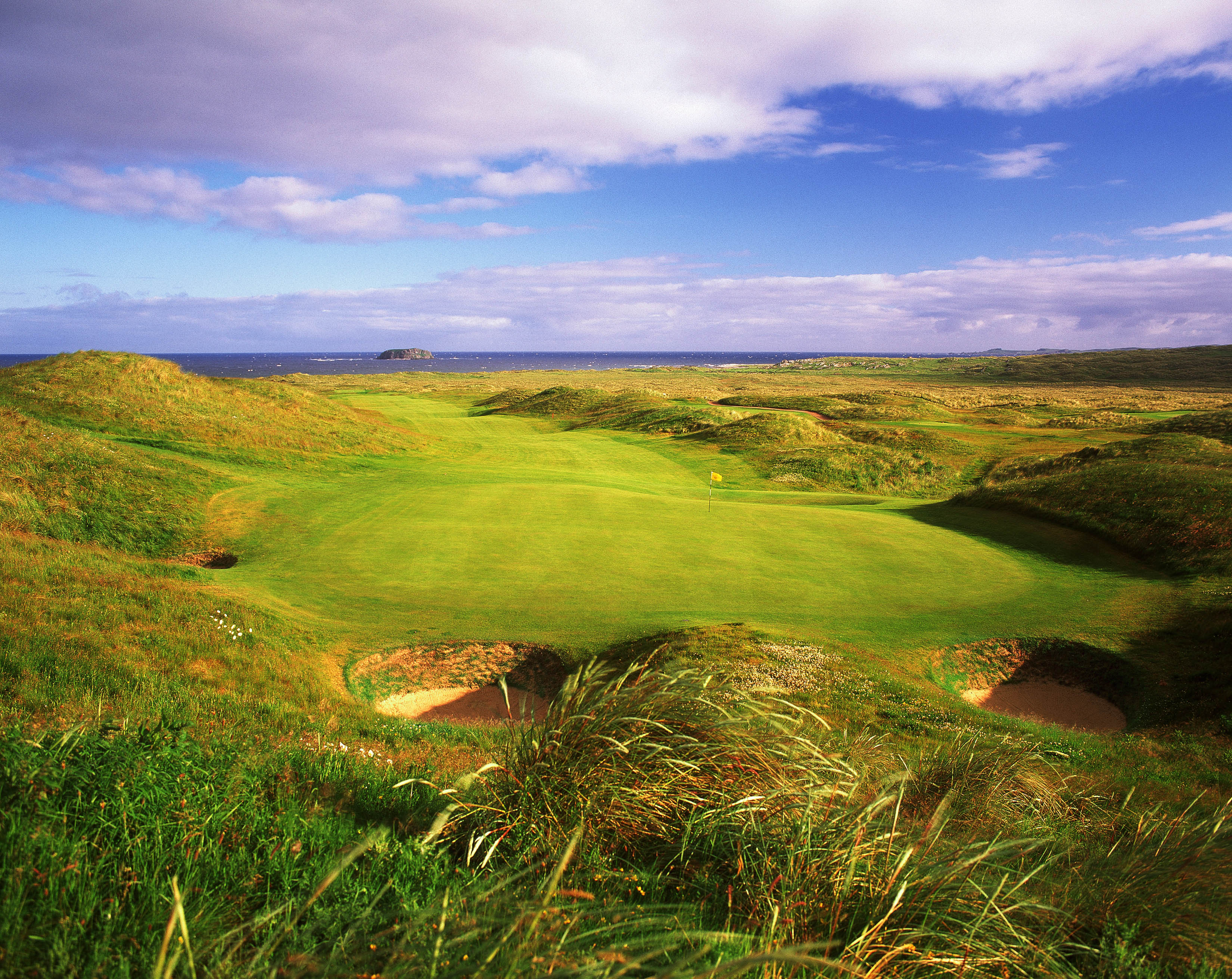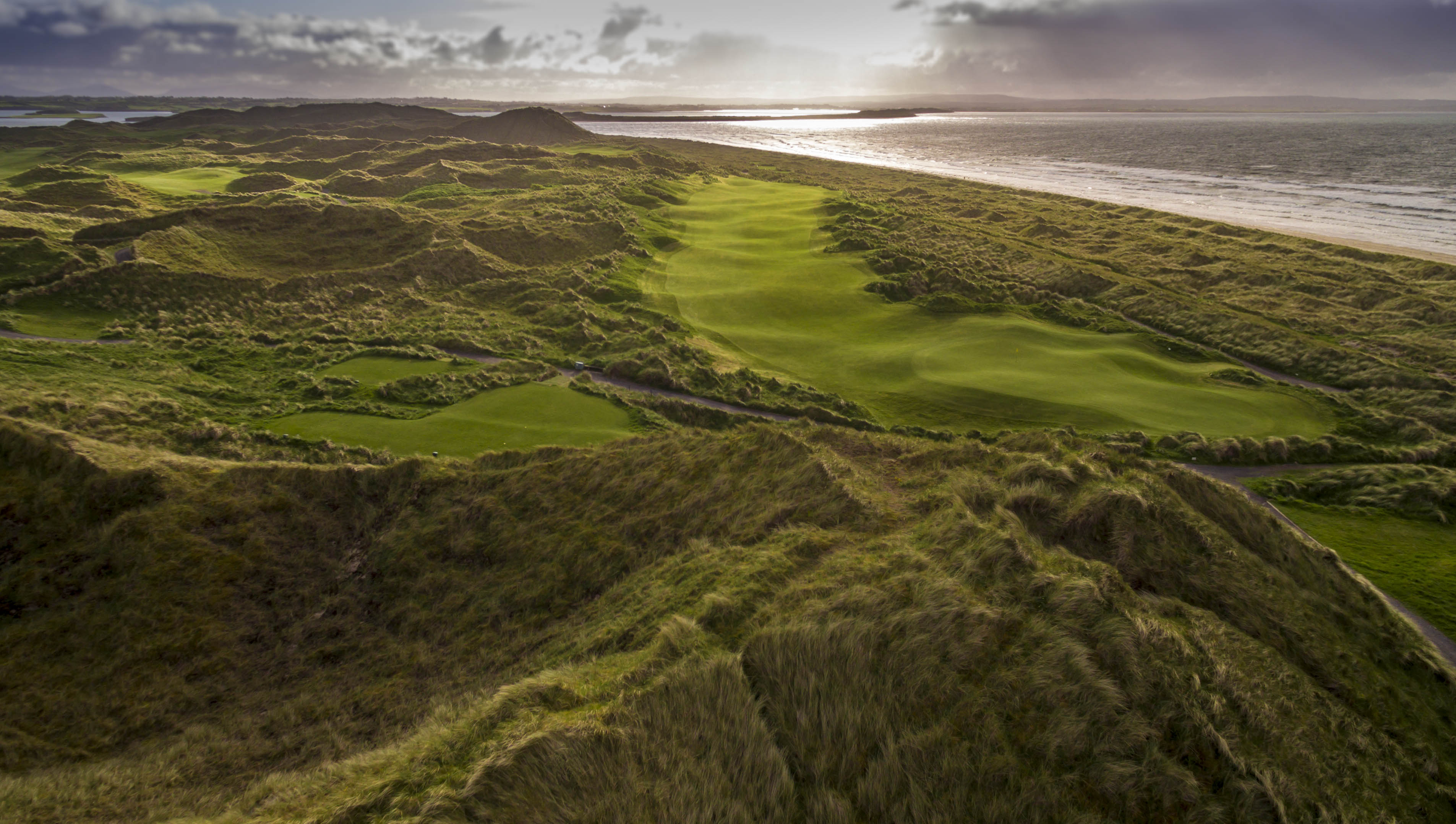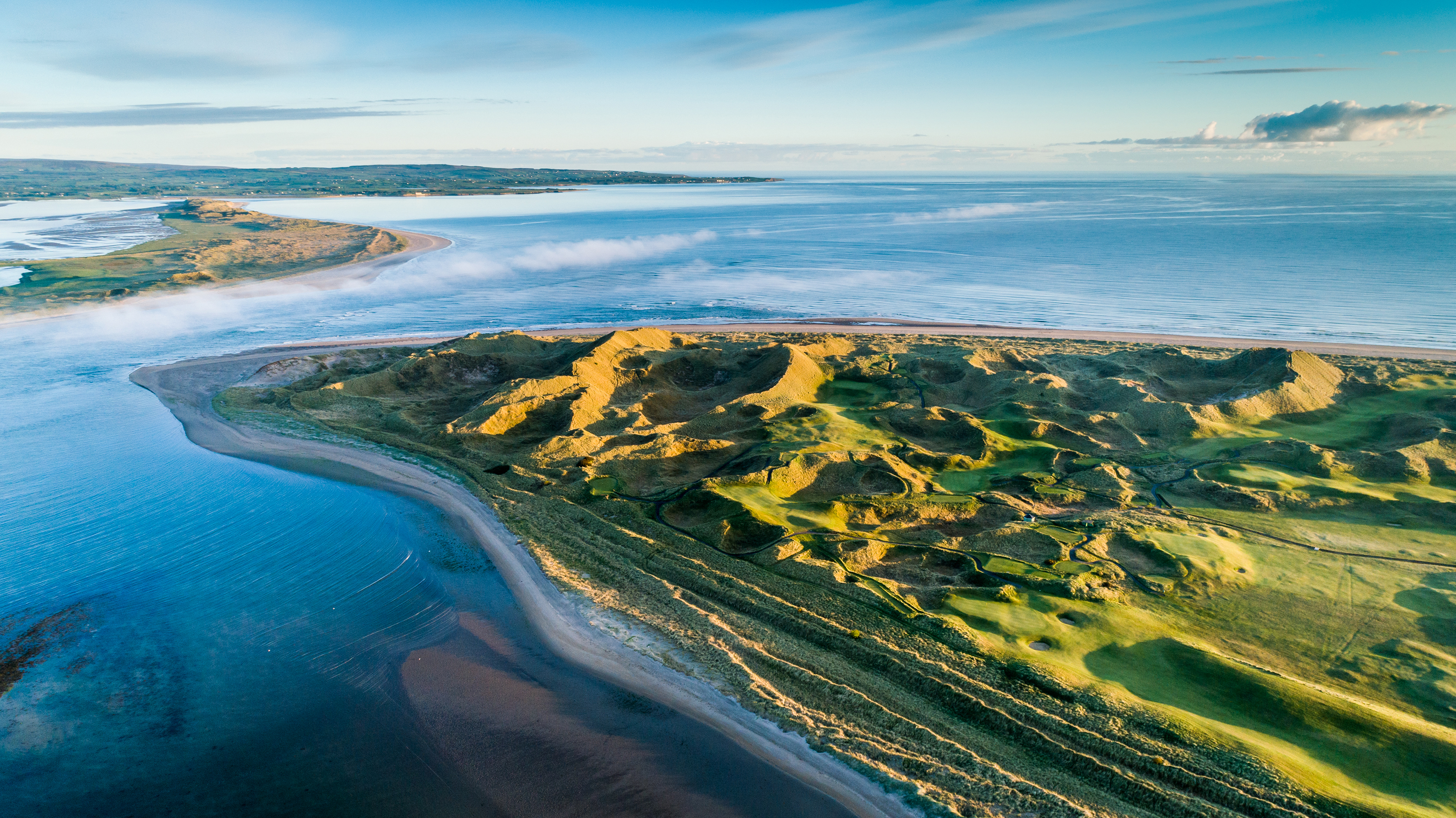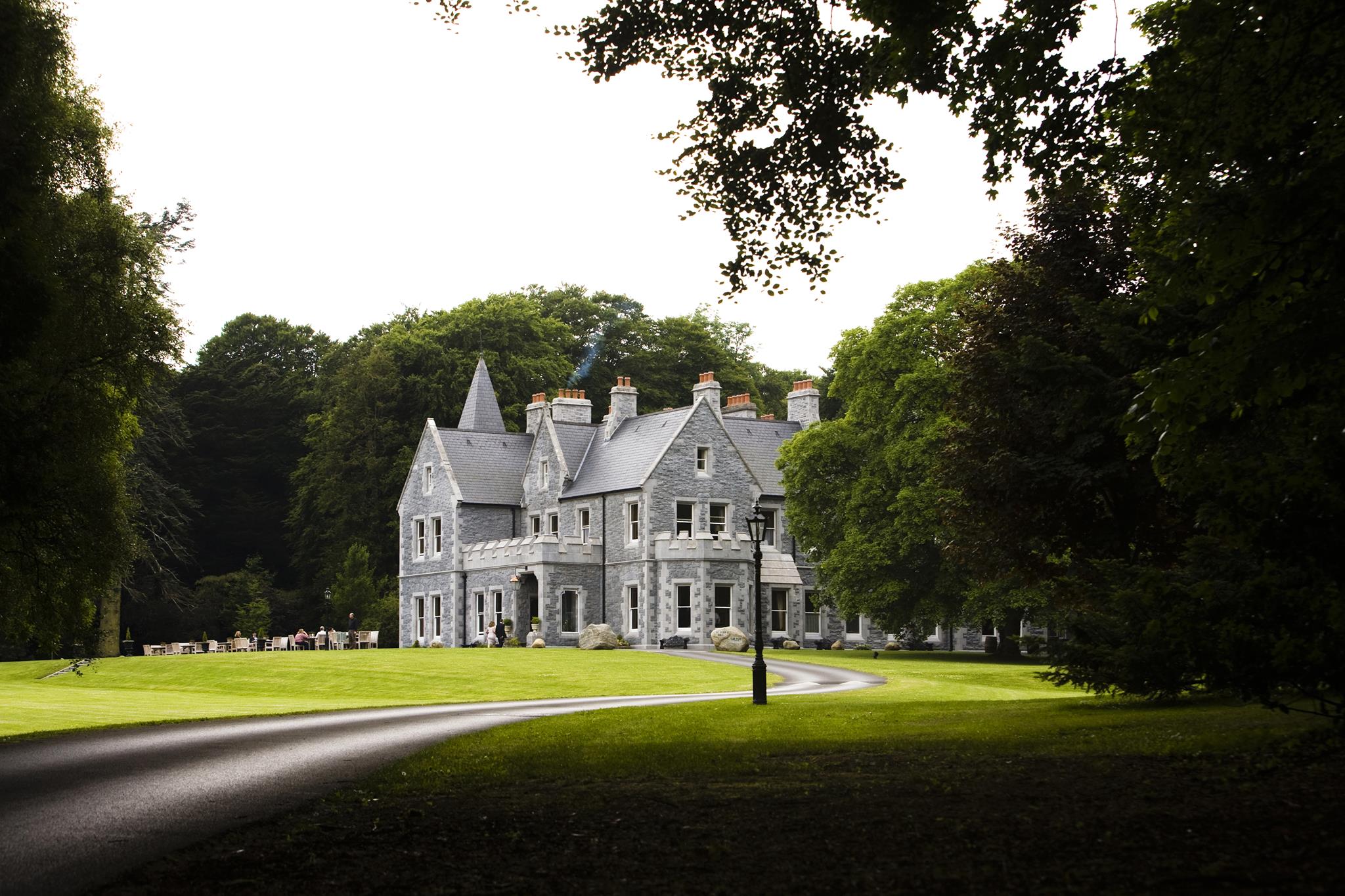The forecast for our long-anticipated buddies trip to the Northwest of Ireland didn’t look good. Seven straight days of rain, it said. Not showers—or scattered showers. Rain. The kind that creates rivers in your shoes and puts Gor-Tex to the test. But we had a secret weapon: my friend Ray.
“Don’t worry,” he said. “It never rains when I go on a golf trip.” Of course, Ray, who hails from hot and sunny New Mexico, had never teed it up in Northwest Ireland. I and my other lifelong friend who’d be joining us, Doug from foggy London, had. There was a reason we both planned to bring two pairs of rain gloves and two pairs of golf shoes. But Ray turned out to be right. Over the course of seven rounds in seven days, 126 holes in all, we encountered rain on just eight of them. We quickly nicknamed our Irish-New Mexican good-luck charm “Ray O’Sunshine.”
Many Americans have no idea how good the links golf is in this part of Western Ireland, which is situated along the northern stretch of the Wild Atlantic Way. Most U.S. golfers head to the southwest, to better known (and much higher-priced) places like Ballybunion and Lahinch. Or up to Northern Ireland to play Royal County Down and Royal Portrush. But I’d played a few of the courses in this part of the Emerald Isle, knew how stellar they were and what great value they offered, and I wanted to see more. So I got in touch with the good folks at North and West Coast Links Golf Ireland and they helped make all the arrangements, as they do for thousands of other visitors to this part of the world every year. John McLaughlin, the group’s CEO, has been spreading the word about the quality of the golf experiences in this region since 1993, and the North and West Coast Links group he heads up just celebrated its 30th birthday. So he knows this area as well as (or better than) just about anyone.
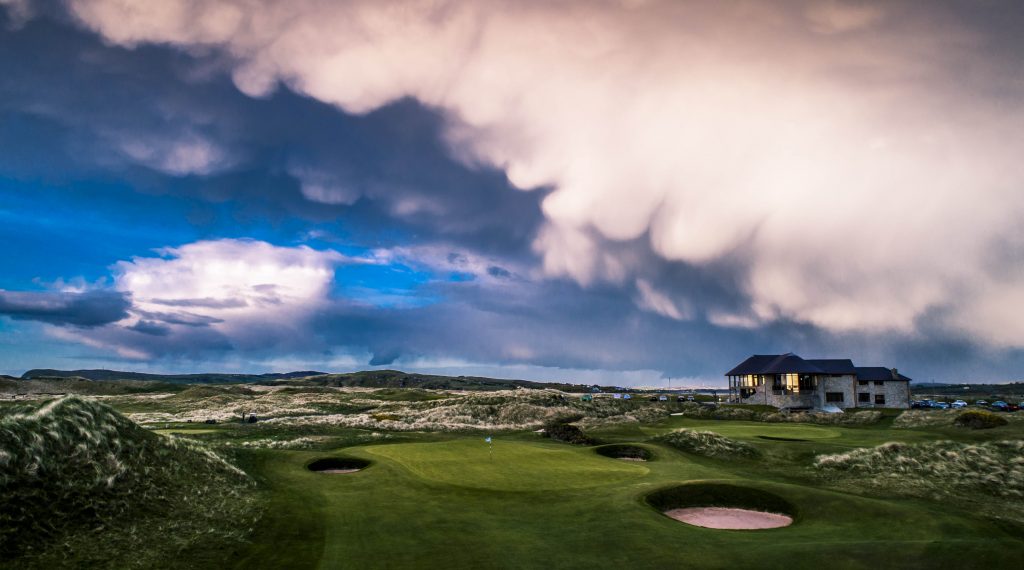
Ballyliffin Golf Club
“With the Irish Open having been staged at Ballyliffin last year, global awareness of the caliber of the golf in our region was given a big shot in the arm,” McLaughlin said. “Golf Insiders knew about us, but a lot of people didn’t. Now, many more do—and we’re seeing them coming in ever-greater numbers from all over the world. There are famous courses here, and not-as-famous ones, but they all offer a spectacular golfing experience, and at the highest playing level. But what makes it so special here is the authenticity of the people and the genuine welcome everyone receives in the West, the Northwest, and Northern Ireland. The hotels and transport options are extensive, and again at the highest standard. But the atmosphere, the scenery, the food, the music, the craic—they are all so special. We think we have the best 19th hole in the world.”
With invaluable help from Paul Collins at the North and West Coast Links, we drew up an itinerary that had my friends and I salivating for months. And in June, we met at Dublin Airport, threw our stuff into a rental car, and set off for what we hoped would be seven memorable days of Irish golf.
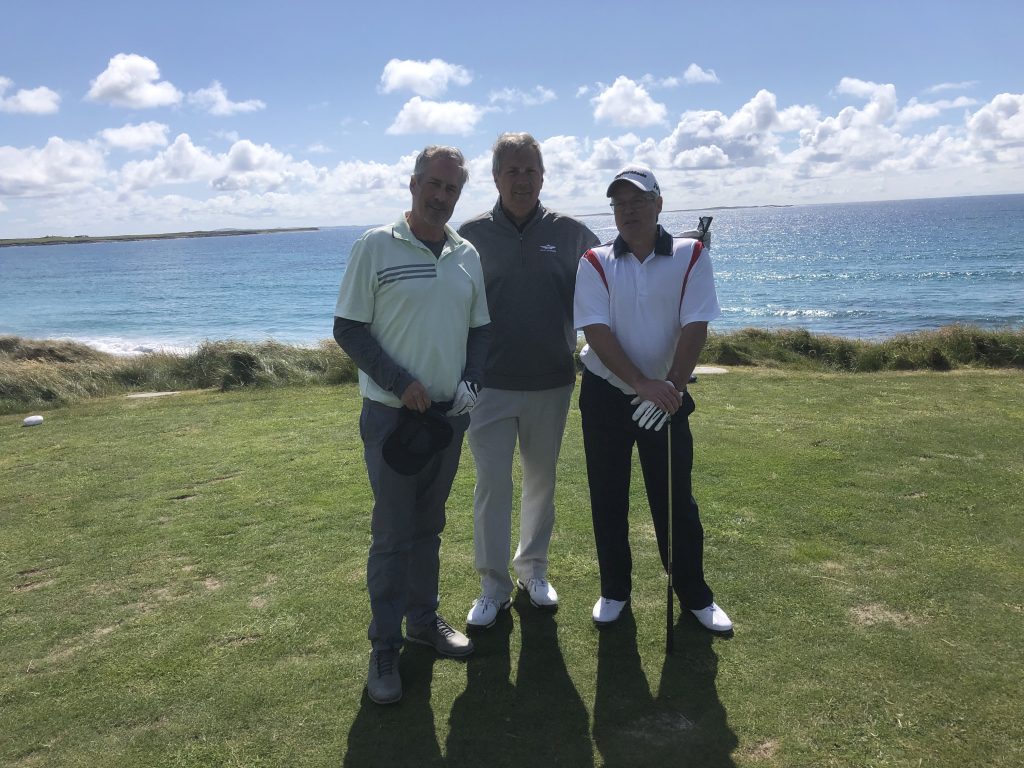
Doug, David, & Ray “O’Sunshine”
Laughs by the Lough
Our first stop, about two hours northwest of the airport, was Lough Erne Resort. Set in the heart of the Fermanagh Lakelands of Northern Ireland, the Nick Faldo-designed course at Lough Erne is not a links. But we thought it would be the perfect place to stop for a warmup round on arrival day, and this parkland gem turned out to be all the golf course anyone could want. Built on 600 hilly acres, the course winds up, down and around Loughs Erne and Castle Hume. Its 7,071 yards proved every inch a championship layout, with creative greensites, strategic bunkering, exhilarating views of the lake and water that came into play on no fewer than 11 holes. It’s hard to crawl off a plane, jump in a car, and head to the first tee without even stopping for lunch. But the course was exhilarating—and demanding. Even though we carded more bogeys and “others” than pars, we laughed our way through it and agreed that the golf was absolutely first-rate, especially on holes like the stern, uphill, 438-yard 8th and the almost driveable 287-yard 10th, whose peninsula green calls for the most precise of wedge shots. The exhilaration extends to the rest of the resort, which has the look and feel of a stately French Chateau. We didn’t spend much time in our spacious rooms, preferring to relax in the restaurant and bar, where we enjoyed excellent food and drink before having a nightcap on the veranda overlooking the lough as the sun set (at 10:30pm!). We joked that it might be our last moment in the sun. Fortunately, that turned out to be anything but the case.
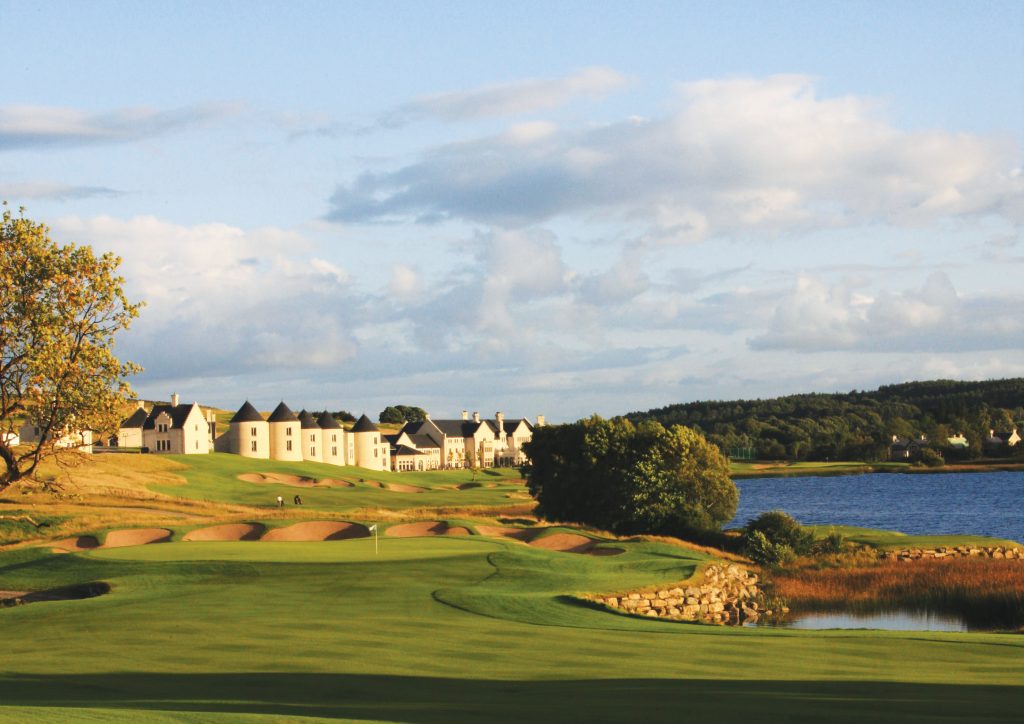
16th hole at Lough Erne
The Links in the Sky
From Lough Erne, with Doug handling the driving-on-the-left duties like a chauffeur in a hurry to get home to his missus, we crossed the border back into the Republic of Ireland and made our way along a series of often narrow two-lane roads to the far northern reaches of Donegal and the Ballyliffin Golf Club, where I’ve been an international member since 2002. Site of the 2018 Irish Open, Ballyliffin has always had a special place in my golfer’s heart. There are two outstanding links courses here: the Eddie Hackett-designed Old Course (1973), a traditional links situated tight to the seashore, and the newer Glashedy Links, which are sited in and amongst higher dunes. I call the Glashedy “The Links in the Sky,” and it would serve as the battleground for our second round of the trip, which started under gray skies and finished in bright sunshine.
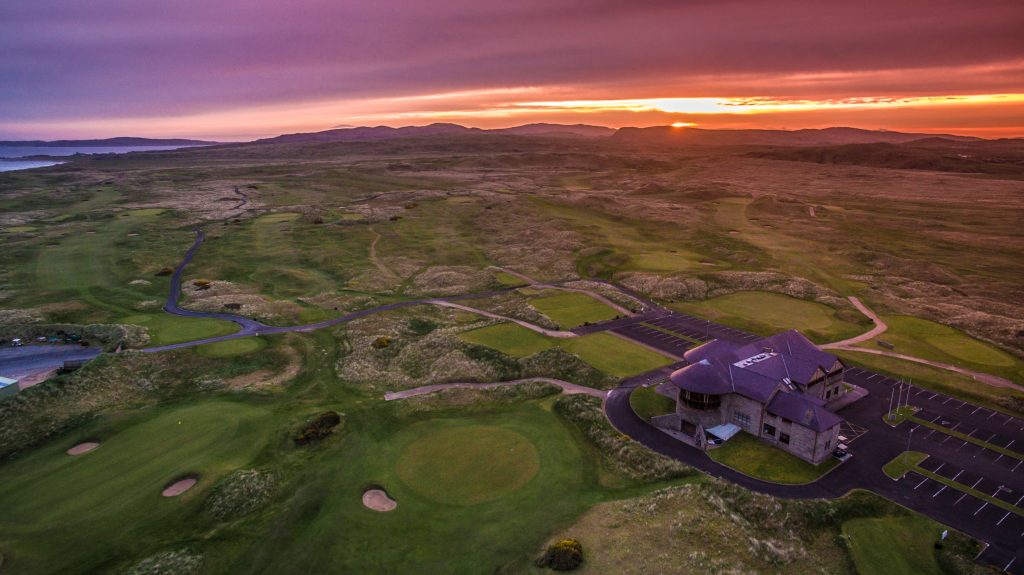
Ballyliffin Golf Club
After a typically warm welcome from ever-smiling General Manager John Farren, who was still basking in the glow of the club’s Irish Open success, we began our round on this Pat Ruddy-Tom Craddock masterpiece behind a group of Irish clergymen who apologized in advance for the possibility that they might hold up our three-ball. They needn’t have worried. The Glashedy Course begins with a trio of mighty par 4s (422, 427, and 426 yards, respectively) that each moves gradually uphill into the higher dunes. Fortunately, this is links golf, so if you keep the ball in the fairway, you can often add 40 or 50 yards of run to a well-struck tee shot. As you summit into these higher sandhills, you encounter one glorious hole after another before plummeting back down to sea level at the dropshot 7th, a 170-yarder that plays more like 120. As we made the turn, the wind picked up, wreaking havoc with tee shots at the 10th, 11th and 12th, where it howled from our left and turned gentle fades into monster slices that sailed into grassy oblivion, never to be found. This wind was at our backs on the uphill 13th, though, making this 571-yard par 5 reachable and gifting one of our party (modesty prohibits me from saying who) with a two-putt birdie. From there, the course plays back down toward Glashedy Rock, the area’s signature moss and stone islet that sits just offshore, with a devilish par 3 followed by a series of stout par 4s and one par 5 that Doug played particularly well as we made our way back to the clubhouse.
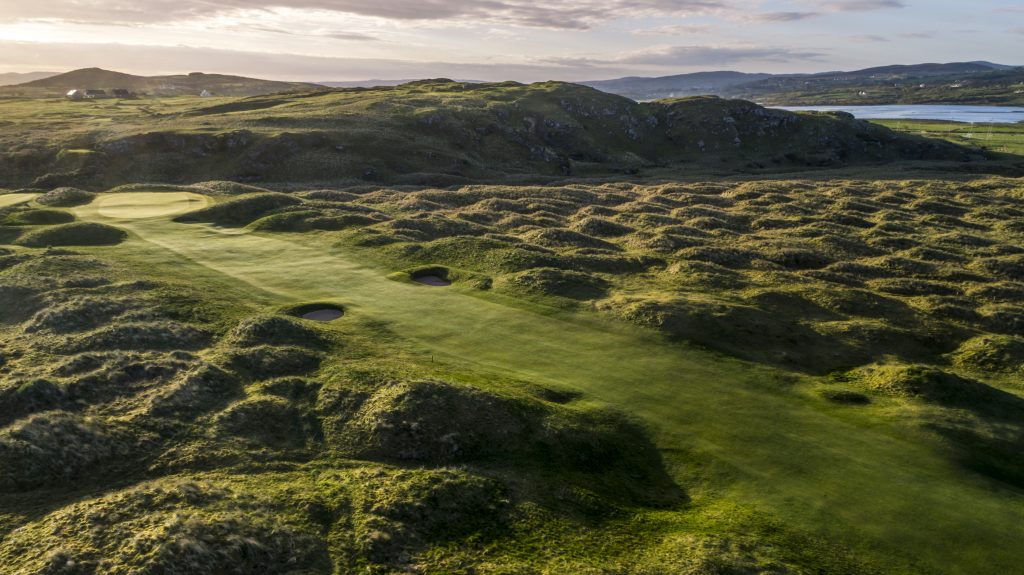
Ballyliffin Golf Club Glashedy Course
There, a perfectly poured Guinness and excellent pub fare awaited, which we gratefully devoured. If we’d had more time, we’d certainly have played the second 18 at Ballyliffin, which so charmed Sir Nick Faldo that he tried to buy the club from its members. But they resisted his advances, and we would have to wait until our next trip to play the wonderful Old Links that grace Ballyliffin’s beautiful seashore. If you get to Ballyliffin, though, you should definitely plan to play both courses. They complement each other well and are equally challenging and enjoyable.
We spent our second evening on Irish soil in the warm and cozy confines of the Ballyliffin TownHouse, a nearby boutique hotel where the guest rooms are exceedingly comfortable and the Irish whiskey selection commendably extensive. After a full Irish breakfast the next morning, complete with mushrooms, baked beans and black pudding in the hotel’s cheery breakfast room, it was back on the road. Round Three awaited us at another Donegal course, Portsalon.

Ballyliffin TownHouse
On to Portsalon
To get to Portsalon Golf Club from Ballyliffin, we had to drive 35 miles due south around the southern tip of Lough Swilly and then head back north another 25 miles on the Fanad Peninsula. Or at least we thought we did. When we arrived at the club to a cheery welcome from general manager Daragh Lyons, we learned that you can take a ferry across the lough from Buncrana to Rathmullan and save 40 minutes of driving. Let that be a lesson to you. Another good lesson: whenever possible, take a caddie. Ray, who was disappointed in the caliber of his game after months of diligent practice leading up to our trip, declined to take one. (“I don’t want to subject anybody to my golf game unnecessarily,” he said.) But Doug and I opted to hire loopers, and we were both glad that we did. My trusty caddie, Andy Boland, proved to be a font of wisdom about the course (where he is a member), as well as the history of the Portsalon area. And on a day when the winds blew hard enough to tip over trollies, his advice proved highly beneficial.
Golf at Portsalon dates back to 1891, and the course still has the feel of a classic links layout, with tumbling fairways, penal pot bunkers, and an amiable antique feel. The two opening holes, a short par 4 to a semi-blind green and a longer Cape hole that requires your tee shot to carry a corner of Lough Swilly beach and your long second shot to avoid a green-front stream, fit the land like they’ve been there for centuries. But the course was actually redesigned in 2000 by Pat Ruddy, with nine new holes added and others considerably lengthened. They needn’t have bothered in our case, because on the day that we played, even short par 4s, like the wonderful 381-yard 14th called “Matterhorn,” became all but unreachable when played into that wind. It gusted so hard, in fact, that two of us had to hit driver on the 159-yard par-3 12th! But that’s what’s links golf is all about: doing battle with the elements and the vagaries of whatever the course architect and seaside terrain demand at any given moment. We learned that when in Ireland, you should do as the Irish do: throw away your scorecard, play match play, and be creative about your shot selection. If the shot calls for a driver off the deck because it’s the only way to gain any distance into the teeth of a monstrous gale, go for it! You’ll not likely have many chances to hit that shot back home.
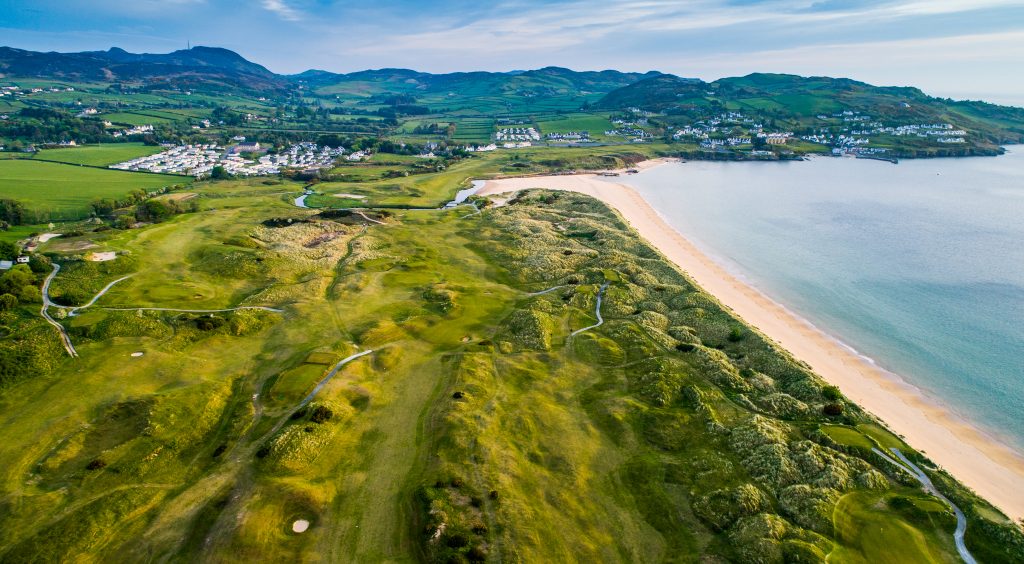
Portsalon Golf Club
When we’d finished our windblown round at Portsalon, we headed south to Letterkenny, where we would spend the next two nights in the lap of luxury at the swanky lux Raddison Blu hotel. I expected Letterkenny to be a sleepy Irish village, but its size and liveliness surprised me. The roundabouts were thick with traffic as we approached town and they remained that way throughout our visit. This did little to diminish our enjoyment of Letterkenny, though, as all those cars meant that the pubs and restaurants would be full of lively Irishmen (and women)—and they were. We celebrated my birthday on our first evening in Letterkenny at a lovely, modern bistro called the Yellow Pepper, where Doug and Ray treated me to a fine steak accompanied by some velvety Ribera del Duero. Of course, we also visited the pub next door, where we were serenaded by an Irish duo who sang traditional ballads while we sampled an assortment of exquisite Irish whiskeys from the Red Breast and Teeling’s distilleries. It may have been a few too many for Ray, whom we would not see again until dinnertime the following day. Or it may be possible that he’d just tired of looking for wind-blown tee shots in the knee-high fescue grasses and fancied a day off. You’ll have to ask him about that.
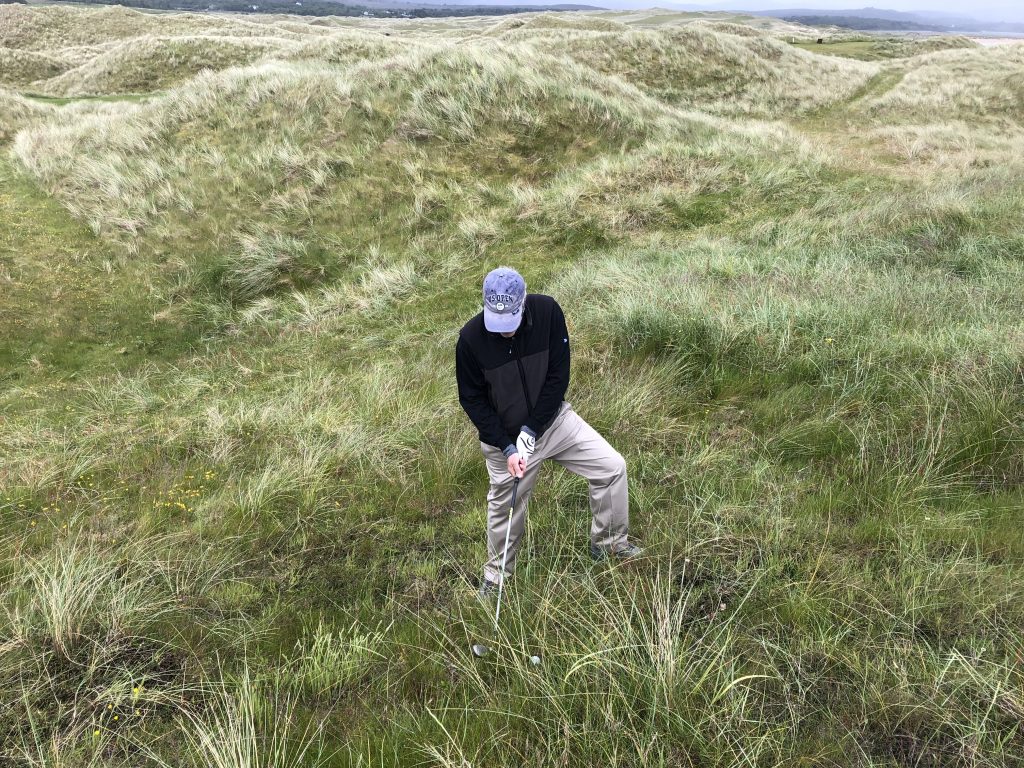
Having fun in the Rough at Portsalon
An Irish Rose
Thursday’s golf, then, took Doug and me to a nearby resort that offers two celebrated links courses—Rosapenna, where you have your choice of an 1893 Old Tom Morris-designed links track, or the Sandy Hills course, a newer layout from, once again, Pat Ruddy. Since arriving back home, it was recently announced that Tom Doak (of Pacific Dunes fame) will be creating a third course at Rosapenna. When that course debuts it will make Rosapenna an even more attractive destination. But the Sandy Hills course would be our Ray-less foe for the day, which had dawned gray and cold enough to require knit caps. And without Ray O’Sunshine along, we worried that our run of dry weather might come to an end. But as we made our way through the high dunes that are your constant companions on the Sandy Hills 18, the temperature rose, the sun peeked out, and the course did its unlevel best to charm us from beginning to end. As was the case on all of these northwest links layouts, flat lies were rarely to be found at Rosapenna. But from the opening hole (a dogleg-right, 483-yard par 5) to the 18th (par 4, 383 yards down a fairway pinched by twin grassy mounds), the course was an absolute delight. No two consecutive holes went in the same direction, and we encountered a surprising amount of elevation changes as we made our way aside, over and through the dunes—along with beautiful natural views of Tramore Beach and sparkling Sheephaven Bay. Hole 6, where you drive over the crest of a hill before playing your second shot down toward the beach and far-off Muckish Mountain, was particularly memorable. We wished that we’d had time to take on the Morris course here, but that would have to wait for another trip. As would a visit to the resort’s stately hotel, which dates back to the turn of the century and allows Rosapenna to lay claim to being the world’s oldest golf resort.
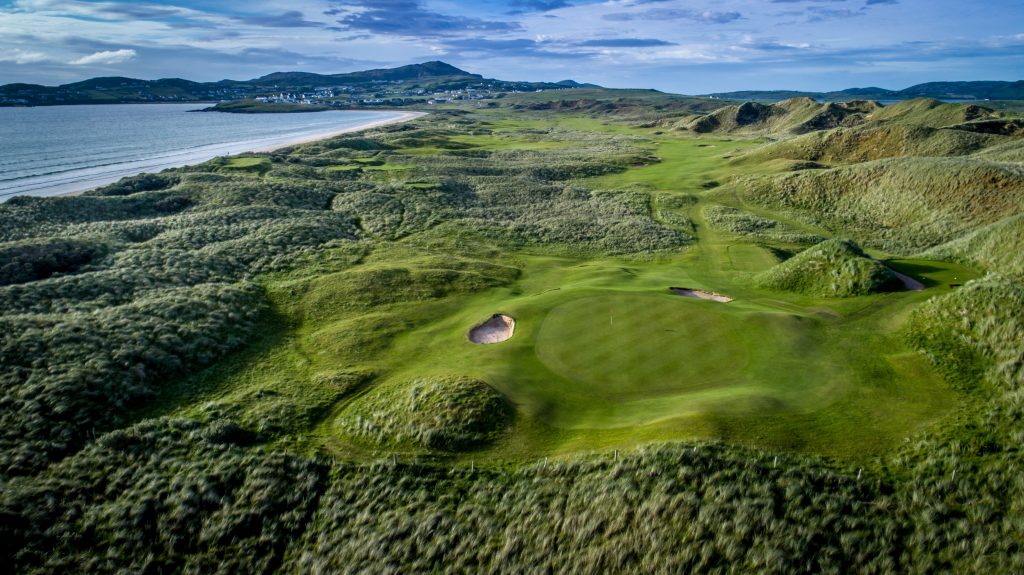
Rosapenna Sandy Hills Course
A Star is Born
I’d heard about Belmullet (a.k.a. Carne Golf Links) from a number of trustworthy sources. “It’s at the end of the world,” they told me,” but you must go. You have to see it to believe it.” Bolstered by those recommendations, we set off from Letterkenny on the fifth morning of our trip to make the drive to Carne, which is situated on Ireland’s left shoulder and is about as close to North America as you can get and still be in Europe. It’s certainly not close to anyplace else! But I’m here to report: that 3-hour drive was more than worth the effort. Because what we discovered at Carne was enough to make me want to sell everything I own and move there. And it all began with the warmth of the welcome that was extended upon our arrival by Fiona Togher, General Manager; Gerry Maguire, Chairman of Erris Tourism, club member Michael McGarry, and John McLaughlin of the North and West Coast Links group, who invited us to sit with them over coffee and hear Carne’s story before we set out to play. Their enthusiasm for the place was palpable; their pride, rightfully, in abundance. Against all odds, and with funds that were limited right from the start, they’d persevered to create something incredibly special at Carne—not just for golfers but for the local area and its inhabitants.
“The town is very much reliant on us,” said Maguire. “Because golfers spend more than the average tourist, it’s worth about €7.2 million to the local economy here in Mayo. Which is huge.”
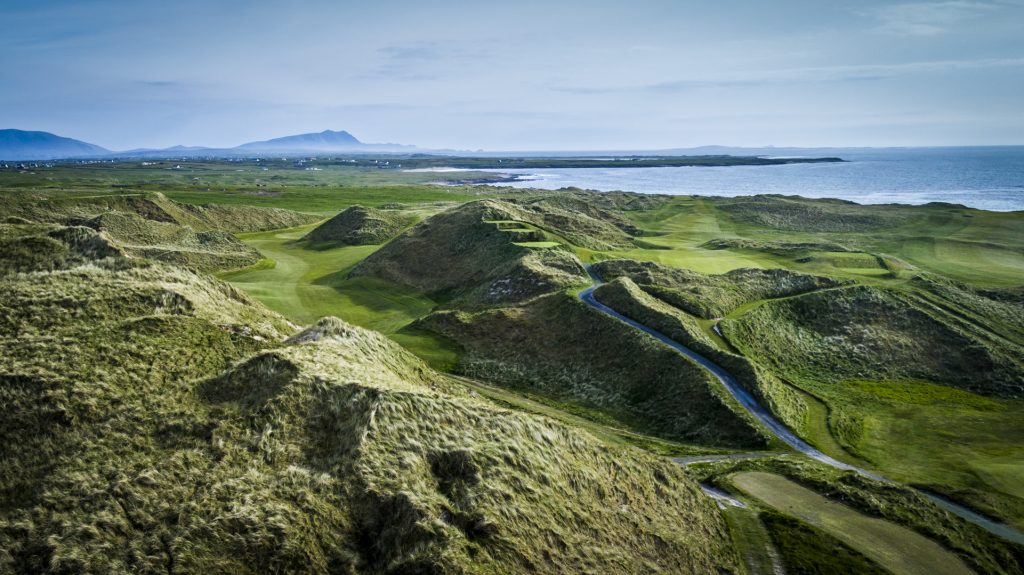
Carne Golf Links
Carne is a not-for-profit entity, Togher explained. The Belmullet GC members who play the course are few and can only contribute around €45,000 euros per year to the upkeep of the links. The rest must come from visitors. As a result, there are just two full-time greenkeepers. But you’d never know it from the excellent condition of the course, which stood up to anything we played on the entire trip. As did the layout and design of the course. In a nutshell: wow.
There are 27 holes at Carne (more on that later) but it was the Hackett 18 that we would play, named for Eddie Hackett, an Irishman who has designed highly regarded courses all around the country. The front nine here eases you into things, starting at the par-4 first that plays up into the towering dunes that dominate Carne’s landscape. On the back nine, the experience revs up even more, with the par-5 10th, and the two following par 4s being real stunners. At the 11th, you play your tee shot straight downhill before the hole bends to the right and requires a short, uphill second shot to a shallow green shelved into the side of a dune. On the next hole, your tee shot is again downhill and your approach shot again uphill, but this time it’s to a green that has literally been carved out of the side of a massive dune, with a steep falloff on the right. The course’s best (and most difficult) hole is undoubtedly the 434-yard 17th, the number-1-handicap hole. Here, you must play a tee shot slightly uphill and ideally with a fade to avoid a falloff into a bowl-shaped ravine choked with high rough on the left. From there, it’s a long iron, hybrid or even a fairway wood depending on the wind to the narrow but deep green, which is protected on the right by yet another steep (and shaved) falloff. Make par on this beast and you’ll have earned serious bragging rights when the round is done and you’re sampling the Guinness in the clubhouse.
But before you do that, you just might want to play the third nine. Scratch that—you absolutely must play the other nine, which was designed by Jim Eng and Addie McIntosh and debuted in 2013. Here on the Killmore Course, the holes are even more intimately routed through the massive dunes of Carne. On the standout par-5 5th, the hole bends steadily to the right between two dunes so high you almost feel as if you’re playing through a tunnel before it culminates at a small green designed to repel all but the most accurate of approach shots. I’ve played more than half of the 230-odd links courses on earth, and I have never seen anything more dramatic than this nine. In time, the club is planning to institute a composite course they’ll call the Wild Atlantic Dunes Course, which will include the Killmore nine plus nine holes from the back nine of the Hackett Course. I’m going to go on record as saying that when this composite 18 opens, it will come to be regarded as one of the most spectacular links courses in the world. And many may label it the most spectacular links course in the world. It’s that good.
Here a look at the beauty of Carne Golf Links:
Flight of the Falcon
After four rounds in four days and all the attendant shuttling of people, bags and clubs from car to hotel to golf course, we were looking forward to putting down roots for a couple nights at the elegant Mount Falcon Estate. Its website had given us some notion of the splendor that awaited—along with a bit of its history, which described the estate as the wedding gift of a well-heeled local to his daughter. But the reality of spending a couple nights at Mount Falcon exceeded even our lofty expectations. Centered around an 1876 Victorian Gothic manor house, the Mount Falcon Estate is a luxurious refuge from the world that offers 32 bedrooms and 45 spacious lodges set amidst 100 acres of primordial woodlands that border the banks of the River Moy in County Mayo. Arriving at the property is like taking a step back in time. Several steps actually.
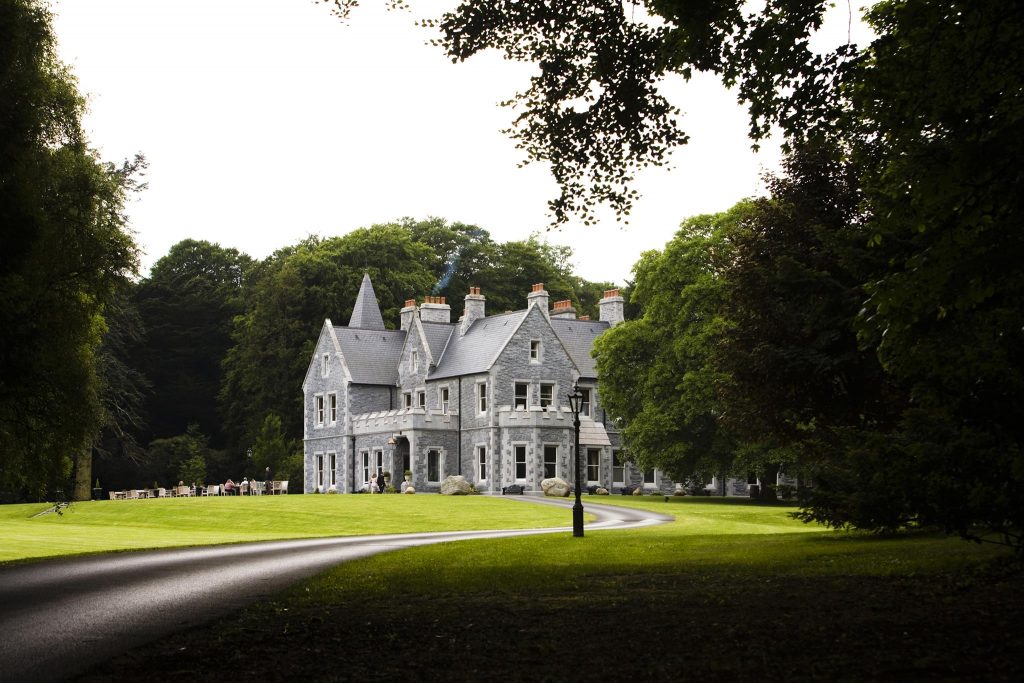
Mount Falcon Estate
The relaxed pace and air of refinement that permeate the entire property have been preserved—and expanded upon—by current owners, the Maloney family, who have invested heavily since assuming control. And the world has taken notice. Tiger Woods and his fellow major champion and friend Mark O’Meara are among the many luminaries who have visited the estate, mostly for its fishing in their case. The stay we enjoyed in one of the 3-bedroom lodges was ideal for our less decorated trio of golfers, and the hospitality truly hearkened back to a kinder and gentler era. With the help of the staff, we watched coverage of the U.S. Open from Pebble Beach in the manor home’s board room, whilst enjoying preprandial pints and perusing the estate’s tantalizing dinner menu. Dinner for me on both nights was the rib-eye steak, served for two and with a bone as long as your forearm. It was superbly flavorful, as were the accompanying side dishes and wine list. While residing at the Mount Falcon, we also had the chance to luxuriate in the estate’s spa and leisure center. The pool, jacuzzi and steam room were just what the doctor ordered after several days of punishing links golf. We didn’t make use of the estate’s golf practice range, but it has a good one. Nor did we have time to do any fishing, clay pigeon shooting, archery, or falconry. Maybe next time—if we can tear ourselves away from the area’s fabulous golf. (Which, in truth, is unlikely.)
Our Penultimate Round: Enniscrone
Golf has been played at Enniscrone at the mouth of the River Moy estuary since the early 1920’s, but it wasn’t until 1974 that the club was able to bar livestock from the course and hire Eddie Hackett to come and make use of the high dunes that dominate its shoreline overlooking blue-green Kalala Bay. In 2001, a redesign by Donald Steel brought more of that dunescape into play and gave us the Enniscrone we know today—a course that’s a must-play for anyone visiting this part of Ireland. The front nine only tiptoes into these dunes here and there, such as at the green of the tough opening hole, which Ray brought to its knees with a massive tee shot and stellar approach. But the opening nine offers fine, strategic golf and is anything but a pushover. And the rippling fairways and well-bunkered greens make Enniscrone a true championship course from start to finish.
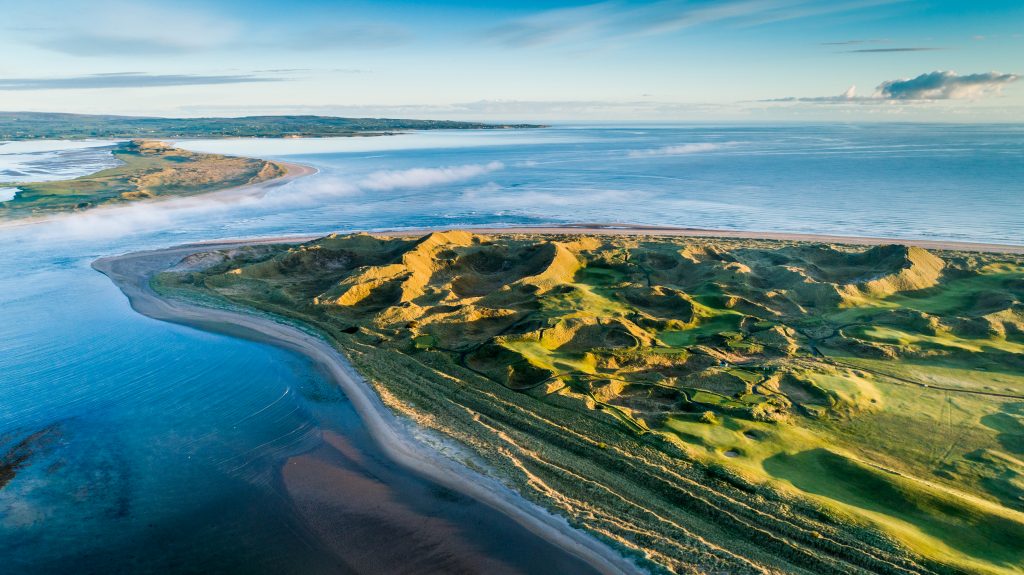
Enniscrone Golf Club
There’s no doubt, though, that it’s Enniscrone’s back nine that’s the real show-stealer. As at Carne, the shaggy, marram grass-covered dunes that frame its holes are not for the faint of heart. Searching for wayward shots (like some of Doug’s occasional snap-hooks) on their steep slopes is akin to undertaking a full-fledged mountaineering expedition. Fortunately, we were on our games for the most part at Enniscrone, with Ray continuing to lead the way with some towering and awe-inspiring tee shots.
The thrills begin in earnest at the dogleg-left, par-4 11th called “Cnoc na gCorp” (“Hill of Bodies”), where you have to be careful not to hit your blind tee shot over the crest of a hill too far, or too far offline. Find the fairway and you’ll have a short iron to the green. But don’t come up short on your approach as we all did, because the green is benched into the side of a dune and anything short will run down the hill and leave an awkward, steeply uphill recovery shot. The scorecard indicates that the following hole, “The Burrows,” is just 338 yards from the middle tees, but it plays sharply downhill between a series of high mounds that narrow the landing area considerably. It’s a heady shot. Find the fairway and you’ll be in birdie city. Miss it, and you may not find your ball. The back nine’s other standout holes include its superb par 5s. Hole 14 swoops and bends uphill and to the right and calls for two sterling hits to get within sight of the green in two. Hole 17 starts along the shoreline then curves inland to the right between two low hillocks before culminating at a shallow and slightly elevated green. Par on either of these longer holes is an excellent score.
I had played Enniscrone twice before Donald Steel reconfigured things, and I enjoyed it back then. Today, the course is even more dramatic and unforgettable. And thanks to Ray O’Sunshine, we had yet to get wet.
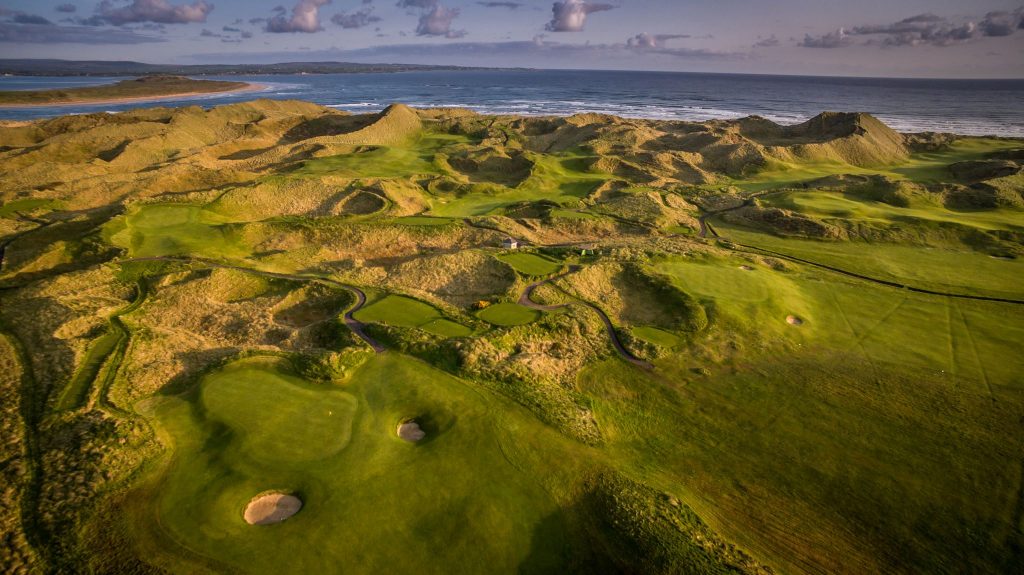
Enniscrone Golf Club
Last Stop: Sligo
County Sligo Golf Club (which also answers to the name of its location, Rosses Point) isn’t the only good golf course in greater Sligo. The aforementioned Enniscrone, the links course at Strandhill, and the Darren Clarke-designed Dargan Castle parkland track are also well worth visiting. But the course at County Sligo GC has been viewed as the fairest of them all by golfing suitors ever since 1929, when famed British golf course architect Harry Colt was brought in to transform the club’s earlier layout into a true, championship 18. The course, which every year hosts the prestigious West of Ireland Championship, was recently tweaked to keep up with the modern game. Several holes were lengthened, and numerous bunkers added to tighten fairways and create new angles of play. The forecast for our round (again) called for rain. And this time, we got it. After starting under gray skies, “Irish sunshine” broke out as we played the 8th hole and stayed with us for a while. But it did nothing to dampen the joy of playing this subtly spectacular course, where Doug rose to the challenge and carded his best round of the week despite having to put rain gloves and umbrella into service.
County Sligo sits in the shadow of mighty Benbulben—the towering glacial mountain made famous in poems penned by local hero William Butler Yeats. Several holes play atop a broad plateau, while the remaining ones are sited lower and closer to Rosses Point’s shoreline. They’re all terrific golf holes. The opening par 4 and its successor both play steeply uphill. Both offer good birdie opportunities, as does the downhill 3rd, a par 5 where you hit from an elevated tee to a fairway that looks even narrower than it is from such a high vantage point. The course really begins to show its mettle at the par-3 4th, “Gan Gaineamh”—which translates as “Without Sand.” It’s true that this 179-yard hole has no bunkers, but it doesn’t need any. The way the green is elevated, with steep runoffs at the front, left and rear, makes it very difficult to get on in regulation with your tee shot. And even when I did, I three-putted.
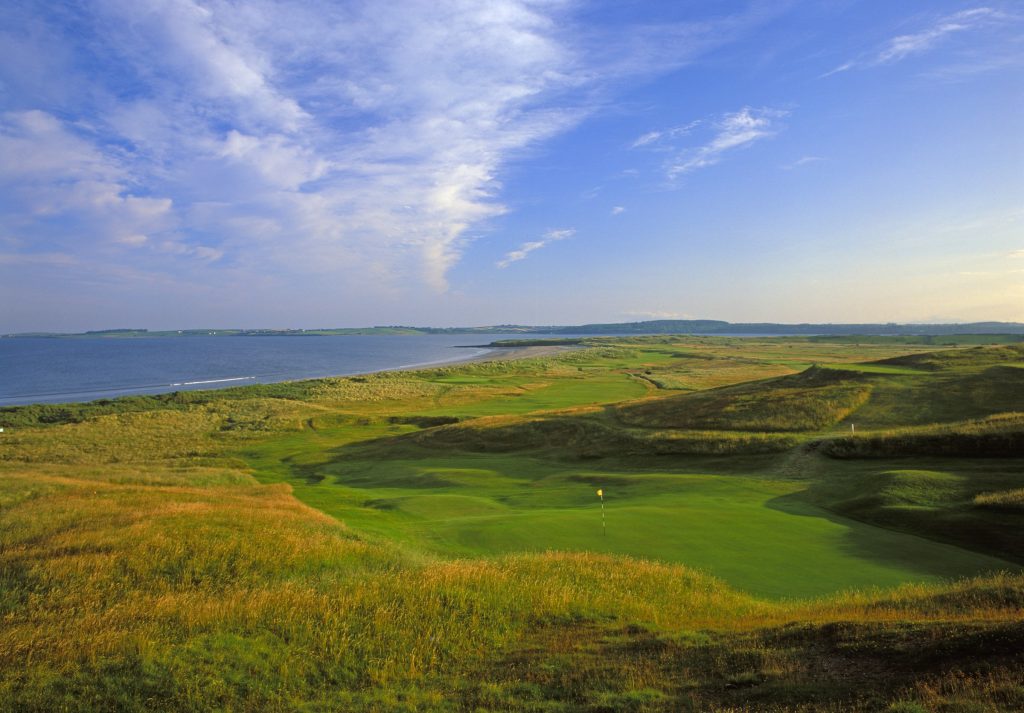
County Sligo Golf Club
From that point on, it’s just one great hole after another, each presenting its own array of natural obstacles to par. The par-4 6th, with a lateral hazard and out-of-bounds all along the right-hand side, and the menacingly long par-4 8th, with its green hugged by another narrow but deadly water hazard, are but warm-up holes for the 433-yard 9th, which rattles nerves with fairway bunkers left and right, a water hazard short of the green, and two greenside bunkers for good measure. Looking at the scorecard, you might think the 152-yard 9th would be an opportunity to catch a breather. But this short hole presents a small target, and pars proved elusive. By the time we’d reached this point in our round, rain was coming down steadily. Ray was routinely picking up, and I was struggling to stay focused. But Doug soldiered on, parring the 9th and then equaling that heady achievement by dropping long par putts on the tight, par-4 10th and uphill, twisting, par-4 11th.
Despite the rain, it was a round that I didn’t want to end—in part because it would signal the end of our trip, and in part because of the unquestionable majesty of the holes we were playing: the uphill-then-downhill par-5 12th, the dropshot 13th to a green surrounded by bunkers, the angular par-4 14th (as demanding as any on the course), the dogleg-right 15th with its upturned-saucer green, and the long, par-3 16th, which called for a 3-wood into a gusty wind. And then there’s 17, one of the great holes in Irish golf in my opinion, because it calls for a long drive that hugs the left of the fairway if you want to have any chance to bust a long iron or fairway wood straight uphill to a distant hillside green. None of us parred it, but none of us really cared. It was an unforgettable experience. And by the time we’d holed out at 18 and had shaken hands for the last time of the trip, we knew it was possible that we’d saved the best for last.

Rainbow at County Sligo
Before leaving County Sligo, I insisted that despite the heavy rain we make a visit to Yeats’ grave at the quaint village church where he is buried, Drumcliffe. Yeats had always been one of my favorite poets, and I wasn’t offended when Doug and Ray opted to stay in the car while I splashed through puddles and hid under an umbrella to read the words inscribed upon his gravestone: “Cast a cold eye/On life, on Death/Horseman pass by.”
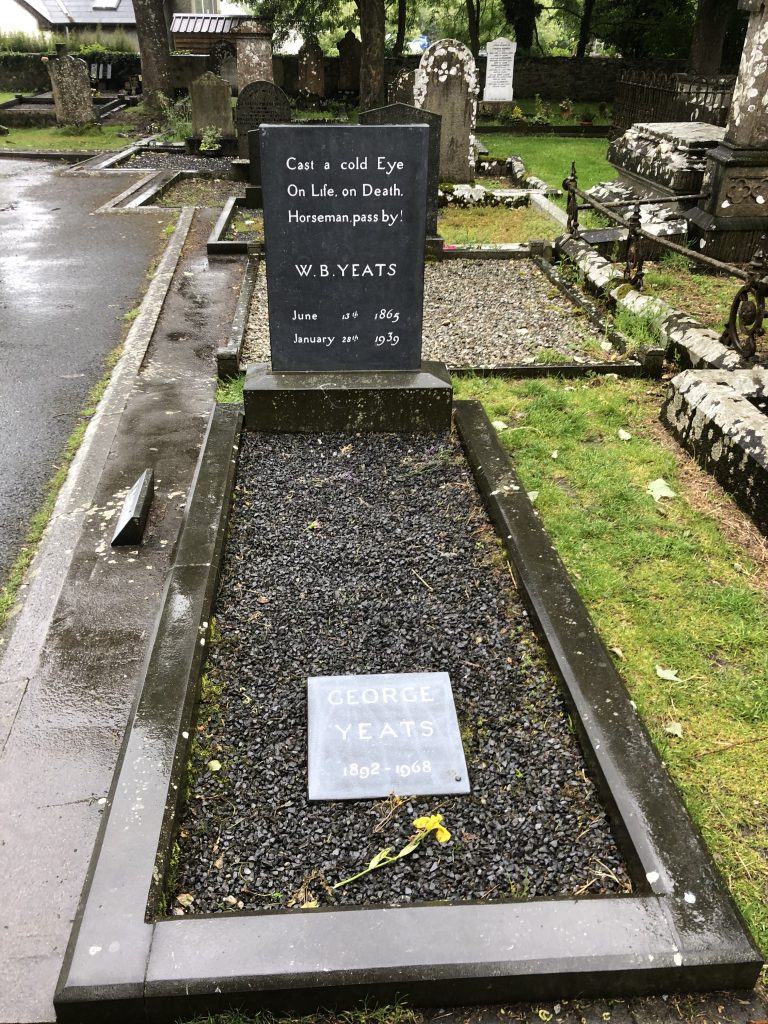
Yeats Gravesite
Saying Our Goodbyes
We hadn’t seen any horsemen on our trip—just lots of deep rough and even more sheep. But there’s no doubt that this part of Ireland has stayed close to its rural roots in the years since golfers started to come calling. Its beauty is authentically natural, and highly seductive. We hadn’t met many Americans along the way, either. But we’d certainly made scores of new friends—from all the incredibly kind people who’d extended such warm welcomes to us at the golf clubs, to the wedding attendees at Mount Falcon, to the receptionists at our final hotel, the Knightsbrook Hotel, Spa and Golf Resort in the town of Trim in County Meath. There, we relaxed in modern accommodations, enjoyed an amazing farewell dinner, and tried to keep our eyes open in the bar to watch the final round of the U.S. Open. We made it through nine holes.
As we said our goodbyes the following morning at Dublin Airport, it was hard to think that our 126-hole adventure had come to a close so soon. We’d shared some amazing adventures. And even though Ray was threatening to quit golf (again), we’d had a great time together. There was talk about a 2020 trip, but I think we all wanted to give this journey through Northwest Ireland some time to sink in. The golf had been everything we’d expected—and more. Thanks to Ray, the weather gods had smiled on us. And no matter how many balls we’d lost or how many putts had refused to drop, it had been a joy to spend time with old and dear friends. Golf’s a great excuse to do that, no matter where your travels take you.

Enniscrone
If you want to follow in our footsteps and experience these amazing courses and this glorious part of the world for yourself, do yourself a favor and go straight to the experts at North & West Coast Links Golf Ireland. They have years of experience, they’re really great to work with, and they can save you a lot of time and money. Plus—you’ll love their accents.
WHERE TO PLAY
Lough Erne Resort – www.lougherneresort.com
Ballyliffin GC – www.ballyliffingolfclub.com
Portsalon GC – www.portsalongolfclub.ie
Rosapenna Hotel & Golf Resort – www.rosapenna.ie
Carne Golf Links – www.carnegolflinks.com
Enniscrone GC – www.enniscronegolf.com
County Sligo GC – www.countysligogolfclub.ie
WHERE TO STAY
Lough Erne – www.lougherneresort.com
Ballyliffin Townhouse – www.ballyliffintownhouse.ie
Radisson Blu Letterkenny – www.radissonblu.com
Mount Falcon Estate – www.mountfalcon.com
Knightsbrook Hotel, Spa and Golf Resort – www.knightsbrook.com
WHAT'S YOUR REACTION?


